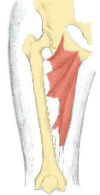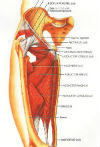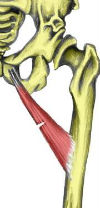Groin Injuries and Prevention Topics

Groin strain causes
What to do if you are an unlucky sufferer from groin strains, and what action you can take to avoid them
A 'groin pull' (aka groin strain) is often a bruise, stretching, or tearing of muscle fibres which run from the front of the hip bone to the inside of the thigh. These 'hip-adductor' muscles, namely the adductor longus, adductor brevis, adductor magnus, gracilis, and pectineus, actively move the thigh toward the centreline of the body ('adduction') and also help to control and limit movements of the thigh away from the body's centre. Thus, the adductor muscles stabilise the hip and leg during all sporting activities which involve running. In some groin pulls, the muscles themselves are okay, but the tendons attaching the muscles to the front of the hip bone are stretched and inflamed. In rare cases, there is an inflammation of the hip bone itself, or even a hair-line fracture of the hip bone. Groin pulls can keep athletes out of action for weeks and even months at a time ('Pelvis and Sacral Dysfunction in Sports and Exercise', Phys Med Rehabil Clin N Am, Vol. 11(4), pp. 805-836, November 2000).

Groin injuries
Groin injuries are injuries to any of the following five muscles - (the pectineus, adductor brevis and adductor longus (called short adductors which go from the pelvis to the thigh bone) and the gracilis and adductor magnus (long adductors which go from the pelvis to the knee).

Adductor - Groin Strain
A groin strain (adductor muscles) is a tear or rupture to any one of the five adductor muscles.




Inflammation of the iliopsoas muscle
What is the Illiopsoas muscle?
The iliopsoas muscle is a very strong muscle that lifts the knee up and controls/supports postural changes. The iliopsoas is important for standing, walking, and running.
The term iliopsoas refers to the combination of the psoas major and the iliacus at their inferior ends. It starts at the lower back and inserts into the thigh bone (femur). This muscle can become inflammed if overworked with situps especially with a weight behind ones' neck, or excessive uphill running. Behind the muscle is a bursa that can become inflammed on it's own or along with the tendon.